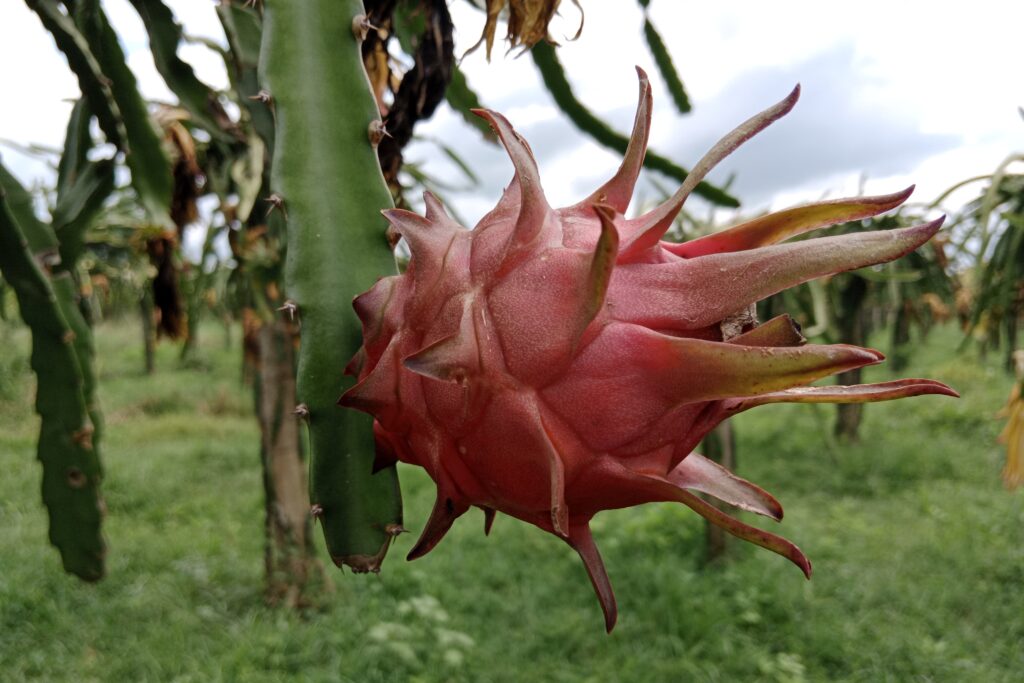Fenugreek Farming
Fenugreek (Trigonella foenum-graecum) is a versatile annual legume grown primarily for its aromatic seeds (used as a spice and medicine) and fresh leaves (as a vegetable/herb). Fenugreek farming profit per acre can be derived from both leaf and seed production, each offering good returns. However, seed production tends to yield a slightly higher profit, with net earnings of NRs. 67,000 per acre compared to NRs. 62,000 from leaf production. As a result, fenugreek seed farming is marginally more profitable per acre and may be the preferred choice, especially when market demand and harvesting conditions are favorable.
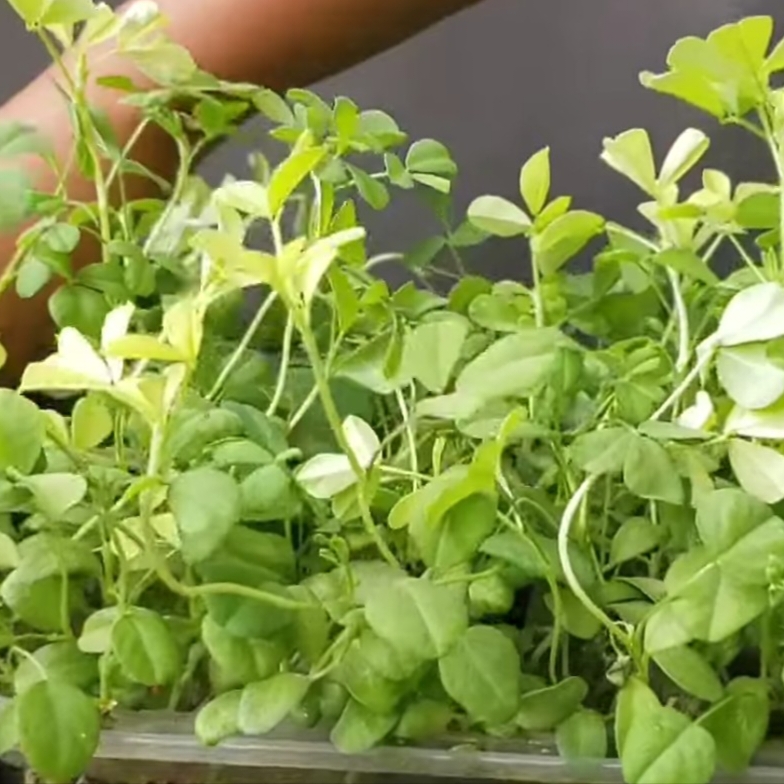
Land Preparation
For successful fenugreek cultivation, land preparation should ensure a well-pulverized, weed-free seedbed to facilitate good germination and establishment, as the seeds are small. Begin with deep ploughing to a depth of 20–25 cm to break hardpans and improve soil aeration and drainage, followed by 2–3 harrowings or discings to break down soil clods. The field should be leveled meticulously to ensure uniform irrigation. During the final tillage operations, incorporate well-decomposed Farmyard Manure (FYM) or compost to enrich soil fertility. Conclude with light planking or rolling to create a fine, firm tilth ideal for sowing.
Soil Type
Fenugreek prefers well-drained loamy soils rich in organic matter, with sandy loam to clay loam being ideal for optimal growth. It can tolerate a wide range of soil types, including moderately saline and alkaline conditions. The optimal pH range for fenugreek is between 6.0 and 7.0, though it can grow in soils with pH ranging from slightly acidic (5.5) to moderately alkaline (8.0). However, heavy clay soils prone to waterlogging and extremely sandy soils with poor water and nutrient retention should be avoided.
Climatic Requirements
| Parameter | Requirement Details |
| Season | Primarily a cool-season crop (Rabi season in India/Subcontinent, Fall/Winter in other regions). Also grown in cooler parts of summer in temperate zones. |
| Temperature | Ideal Range: 10°C to 30°C (50°F to 86°F) |
| · Germination: 15°C to 25°C (59°F to 77°F) optimal | |
| · Growth: Thrives best at 20°C to 25°C (68°F to 77°F) | |
| · Sensitivity: Seedlings sensitive to frost. Extreme heat (>35°C / 95°F) during flowering/podding causes flower drop, reduced pod set, and poor seed quality. | |
| Rainfall | Requires moderate moisture. Performs best under irrigation in areas with low/erratic rainfall. Excessive rain/humidity promotes diseases. |
| Sunlight | Needs ample sunlight to achieve optimal growth and maximum seed production. |
Major Cultivars
Availability of fenugreek cultivars varies significantly by country and region, so it is essential to choose varieties that are specifically recommended for your local agro-climatic zone to ensure optimal performance and yield. Cultivars are often categorized by use and regional adaptation. Common types include:
| Cultivar Type | Examples | Characteristics |
| Seed Types | Kasuri, Pusa Early Bunching, RMt 1, RMt 143, Gujarat Methi No. 2, CO 1, Lam Selection 1, Pant Ragini, Rajendra Kranti | Taller plants Later maturing Higher seed yield |
| Leafy Types | Pusa Kasuri, Hisar Sonali, EC 4911 | Bushier growth habit Faster growing Higher leaf yield |
| Dual Purpose | Many cultivars used for both purposes | Versatile use for both seeds and leaves Some specifically bred for superior seed OR leaf yield |
Seed rate per acre
Always use certified, disease-free seeds obtained from a reputable source and treat them with fungicides such as Thiram or Captan at 2–3 g per kg of seed, or with bio-agents like Trichoderma, to ensure healthy germination and minimize the risk of seed-borne diseases. Seed treatment with Rhizobium culture specific for fenugreek is highly beneficial for nitrogen fixation.
| Purpose of Cultivation | Seed Rate per Acre | Notes |
| Seed Production | 8 – 12 kg | Lower density for optimal seed development |
| Leaf/Vegetable Production | 20 – 25 kg | Higher density for tender leaf harvest |
Planting
a). Planting Season
Fenugreek is primarily planted during the Rabi season from October to November, but it can also be grown during June to July in cooler highland areas (Kharif season) and in February to March for the spring or summer season in the plains.
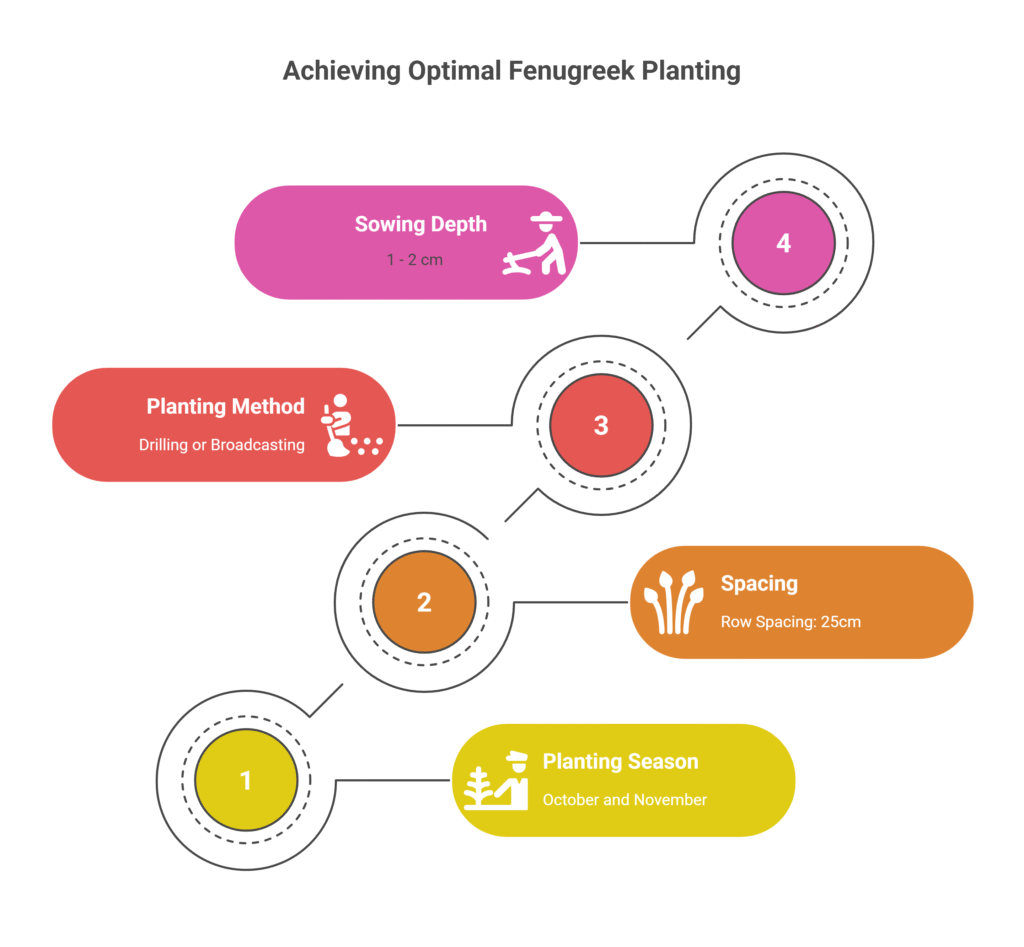
b). Spacing
A spacing of 25 cm is maintained between rows.
c). Planting Method
| Planting Method | Description | Key Considerations |
| Broadcasting | Seeds evenly scattered over prepared field and lightly covered with soil using rake/harrow | • Common for leafy types • Requires higher seed rate • Makes weeding/harvesting harder |
| Drilling | Seeds sown in continuous lines (drills) using seed drill or behind plough at specified row spacing | • Most common/recommended method • Ensures uniform depth and spacing • Depth: 1-2 cm (0.5-1 inch) |
| Sowing Depth | Critical parameter for all methods due to small seed size | • Absolute Maximum: 2-3 cm (1 inch) • Ideal Range: 1-2 cm (0.5 inch) • Deeper sowing drastically reduces emergence |
Intercropping
Fenugreek is exceptionally well-suited for intercropping due to its short stature, rapid growth cycle, and beneficial nitrogen-fixing ability. Common companion crops include taller, slow-growing Rabi season staples such as Wheat, Barley, Sugarcane (during its early stages), and Mustard; it is also effectively paired with other winter vegetables and legumes like Onion, Garlic, Potato, and Chickpea.
Typically, fenugreek is sown in 2-3 rows between the rows of the main crop. This practice offers significant advantages: it maximizes land and water use efficiency, generates additional income from the same field, naturally suppresses weed growth through ground cover, and enriches soil nitrogen levels for the primary crop.
Irrigation
| Aspect | Details |
| Critical Stages | Germination, Flowering, Pod Development |
| General Frequency | Light & frequent irrigations (especially in sandy soils); Avoid waterlogging |
| Germination Stage | Pre-irrigate field OR irrigate immediately after sowing. Keep surface moist until seedlings establish. |
| Vegetative Stage | Irrigate every 7-10 days (adjust based on soil type, weather, and rainfall). |
| Flowering & Podding | Irrigate every 5-7 days if needed. Stress here severely reduces seed yield. |
| Irrigation Method | Preferred: Furrow (efficient), Sprinkler Avoid: Flooding |
| Pre-Harvest (Seeds) | Withhold irrigation 10-15 days before harvest to facilitate drying. |
| Pre-Harvest (Leaves) | Maintain consistent moisture until the final harvest. |
Fertilizer and Manure
Fertilizer and manure applications should be adjusted according to soil test recommendations to ensure balanced nutrient supply and optimal crop growth.
| Application Timing | Fertilizer Type | Recommendation per Acre | Notes |
| Basal Dose (At sowing) | Organic | 8-10 tonnes of well-rotted FYM or compost | Incorporated during land preparation |
| Biofertilizer | • Azospirillum: 1 kg • PSB (Phosphate Solubilizing Bacteria): 1 kg • Potash Mobilizing Bacteria: 1 kg | Applied during soil preparation | |
| Inorganic (NPK) | • N: 20 kg • P₂O₅: 40 kg • K₂O: 20 kg (e.g., 100-125 kg DAP + 35 kg MOP or equivalent) | Adjust based on soil test results | |
| Top Dressing (30-35 DAS) | Nitrogen | 20 kg N (e.g., 45 kg Urea) | Primarily for leafy varieties, apply 30-35 days after sowing (DAS) |
Weed Control
The critical period for weed control in fenugreek is the first 30–40 days after sowing, until canopy closure. During this time, maintain a weed-free field by conducting one or two hoeing operations—first weeding at 25–30 days after sowing and the second around 30 days later. For chemical control, apply Fluchloralin at 800 ml per acre before planting, or spray Pendimethalin at 1.3 liters per acre mixed with 200 liters of water within 1–2 days of sowing when adequate soil moisture is present. Additionally, when plants reach about 4 inches in height, they perform pinching to promote branching.
Flowering and Fruit Management
Flowering in fenugreek begins 30–45 days after sowing, depending on the cultivar and season, with yellow-white papilionaceous flowers forming in the leaf axils and continuing to bloom over several weeks. The crop is primarily self-pollinated, though some insect-mediated cross-pollination may occur. These flowers develop into slender, pointed pods measuring 10–15 cm in length, each containing 10–20 seeds, with pod maturation progressing from the bottom upwards. Proper management during this stage involves maintaining adequate moisture and nutrient levels, avoiding water stress and excessive nitrogen, and regularly monitoring for pests and diseases to ensure healthy flowering and fruit development.
Pest and Disease Management
Common Pests
a). Aphids
If an aphid infestation is observed, it can be controlled by spraying Imidacloprid at 3 ml per 10 liters of water or Thiamethoxam at 4 grams per 10 liters of water.
b). Pod Borers
Pod borers damage fenugreek by boring into pods and seeds, reducing yield. Control measures include pheromone traps, neem or Bt sprays, and insecticides like spinosad or chlorantraniliprole, applied at 4 kg per acre for effective management.
c). Whiteflies
Whiteflies damage fenugreek by sucking plant sap and transmitting viral diseases. They can be managed using yellow sticky traps, neem oil, or insecticides such as spiromesifen and pymetrozine. Additionally, spraying Imidacloprid at 3 ml per 10 liters of water or Thiamethoxam at 4 grams per 10 liters of water is effective in controlling their population.
d). Cutworms
Cutworms damage fenugreek by severing seedlings at the base, often causing significant stand loss. They can be effectively controlled by soil drenching around the seedlings with a mixture of Profenofos and Cypermethrin at 2 ml per liter of water.
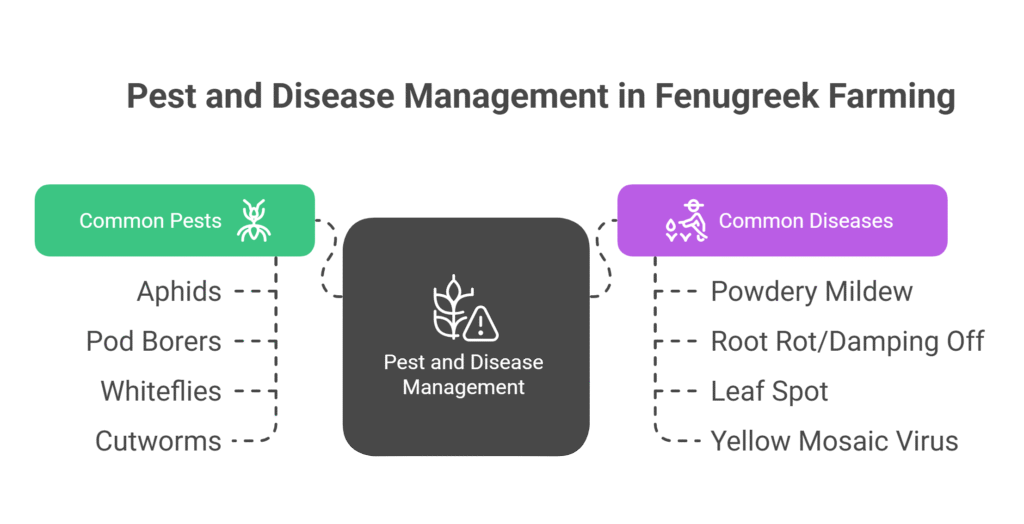
Common Diseases
a). Powdery Mildew
Powdery mildew appears as patchy, white, powder-like growth on the upper surface of fenugreek leaves. If symptoms are observed, apply a spray of water-soluble sulphur at 20 grams per 10 liters of water. If necessary, repeat the spray after a 10-day interval. Additionally, spraying Penconazole 10% EC (Topas) at 200 ml per acre mixed in 200 liters of water can provide effective control.
b). Root Rot/Damping Off
To prevent root rot in fenugreek, apply neem cake to the soil at 60 kg per acre and treat seeds with Trichoderma viride at 4 grams per kilogram of seed. If root rot infestation is observed in the field, control it by drenching the affected soil with Carbendazim at 5 grams per liter of water or Copper Oxychloride at 2 grams per liter of water.
c). Leaf Spot
Leaf spots in fenugreek, caused by various fungal pathogens, can be managed by spraying Mancozeb at 3 ml per liter of water or Chlorothalonil at 2 ml per liter of water to effectively control the disease and protect the foliage.
d). Yellow Mosaic Virus
Yellow Mosaic Virus in fenugreek is transmitted by whiteflies and leads to stunted plant growth and yellow mosaic patterns on the leaves. Effective management includes controlling the whitefly population, removing and destroying infected plants, and using resistant varieties to prevent the spread of the disease.
Harvesting
| Purpose | Aspect | Details |
| Fresh Leaves | First Cutting | 25-30 days after sowing; cut plants 3-4 cm above ground. |
| Subsequent | Every 15-20 days (2-3 possible cuttings). | |
| Timing | Harvest in the morning for optimal freshness. | |
| Seeds | Timing | Harvest when 70-80% pods turn yellowish-brown, lower leaves drop, and seeds are hard/detachable. Avoid delay (causes shattering). |
| Method | Cut plants close to ground using sickles. Avoid uprooting in muddy soil. | |
| Threshing | Sun-dry plants for 3-7 days. Beat with sticks/mechanical threshers; winnow to clean seeds. | |
| Drying | Sun-dry cleaned seeds until moisture content < 10% for safe storage. |
Yield
| Yield Type | Quantity Range | Additional Details |
| Seed Yield | 200 – 300 kg/acre | Varies by cultivar, climate, & management. |
| Green Leaf Yield (Fresh) | 1600 – 2000 kg/acre | From 2-3 harvests; Depends on plant density & number of cuttings. |
Cost of Investment Per Acre for Fenugreek Farming
| S.N. | Categories | Cost (NRs.) |
| 1 | Land Preparation (Plowing) | 15,000 |
| 2 | Seed | 1,000 |
| 3 | Sowing | 3,000 |
| 4 | Fertilizers and Manure | 5,000 |
| 5 | Irrigation | 3,000 |
| 6 | Weed Control (Pre & Post) | 2,000 |
| 7 | Pest & Disease Control | 3,000 |
| 8 | Harvesting | 3,000 |
| 9 | Miscellaneous Costs | 3,000 |
| Total Cost | 38,000 |
Income from Per Acre Fenugreek Farming
| Particulars | Estimated Yield (kg) | Market Price (NRs/kg) | Total Income (NRs.) |
| Fresh Leaves Yield | 2,000 | 50 | 100,000 |
| Seed Yield | 300 | 350 | 105,000 |
Analysis of Fenugreek Farming Profit Per Acre
| Type of Production | Total Income (NRs.) | Total Cost (NRs.) | Net Profit (NRs.) |
| Leaf Production | 100,000 | 38,000 | 62,000 |
| Seed Production | 105,000 | 38,000 | 67,000 |
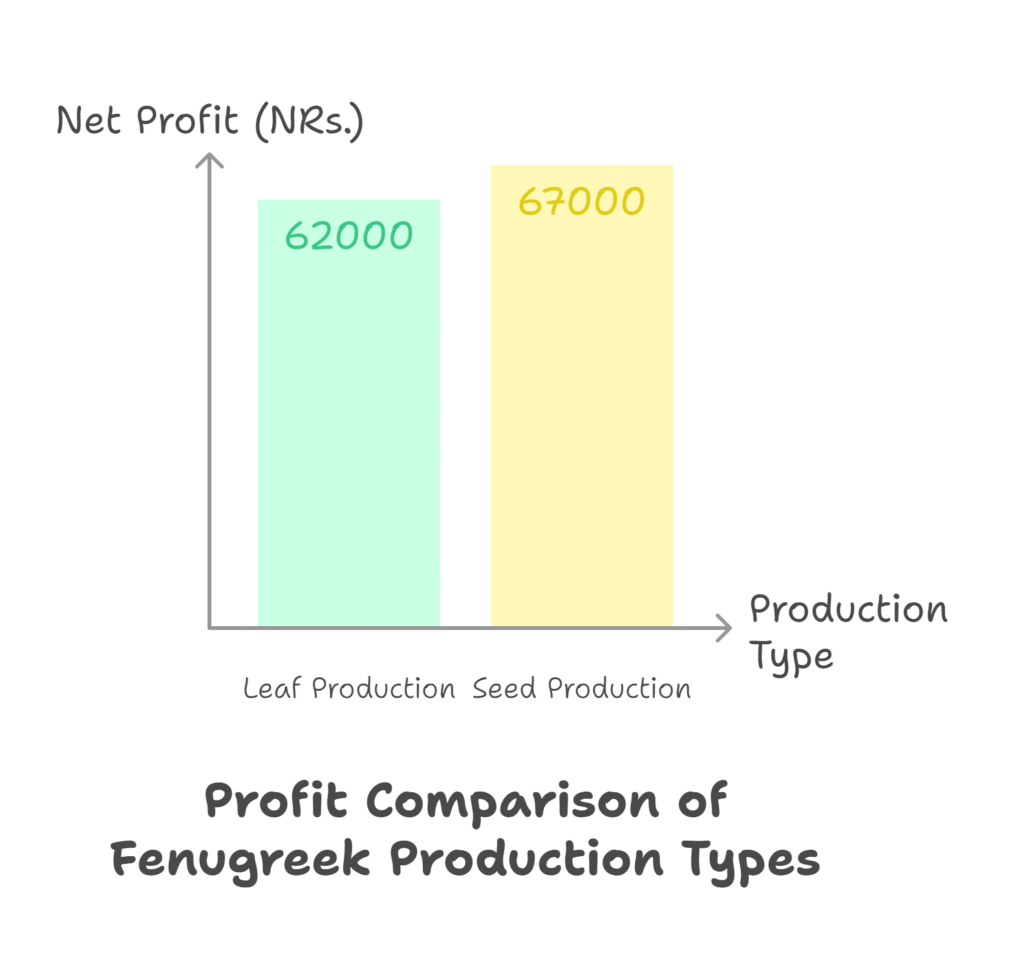 Both leaf and seed production of fenugreek are profitable ventures, but seed production yields a slightly higher profit of NRs. 67,000 per acre compared to NRs. 62,000 from leaf production. Therefore, fenugreek seed farming is marginally more profitable per acre and may be preferred if market demand and harvesting conditions are favorable.
Both leaf and seed production of fenugreek are profitable ventures, but seed production yields a slightly higher profit of NRs. 67,000 per acre compared to NRs. 62,000 from leaf production. Therefore, fenugreek seed farming is marginally more profitable per acre and may be preferred if market demand and harvesting conditions are favorable.
Crop Calendar for Fenugreek Farming (Rabi Season Focus)
| Growth Stage | Timing | Key Activities | Technical Specifications |
| Land Preparation | 15-30 days before sowing | • Deep ploughing (20-25 cm) • 2-3 harrowings • Leveling • Incorporate 8-10 tonnes FYM/compost • Apply basal NPK (20:40:20 kg/acre) | Soil: Loamy, pH 6.0-7.0 Avoid: Waterlogged/heavy clay soils |
| Sowing | Rabi: Oct-Nov Kharif: Jun-Jul (highlands) Summer: Feb-Mar | • Seed Treatment: Thiram/Captan (2-3g/kg) + Rhizobium • Method: Drilling (25 cm row spacing) • Depth: 1-2 cm • Seed Rate: – Seed production: 8-12 kg/acre – Leaf production: 20-25 kg/acre | Post-Sowing: Light irrigation immediately |
| Germination | 0-10 DAS | • Maintain surface moisture • Monitor damping-off disease | Optimal Temp: 15-25°C |
| Vegetative Stage | 10-40 DAS | • 1st Weeding: 25-30 DAS (hoeing) • Pre-em. Herbicide: Pendimethalin (1.3L/acre) • Irrigation: Every 7-10 days • Top Dressing (Leaf): 20 kg N/acre (30-35 DAS) | Pinching: At 10 cm height to promote branching |
| Flowering | 40-50 DAS | • Critical Irrigation: Every 5-7 days • Monitor pests (aphids, whiteflies) • Disease prevention (powdery mildew) | Temp Sensitivity: >35°C causes flower drop Self-pollinated |
| Pod Development | 50-90 DAS | • Pest Control: Pod borers (spinosad), whiteflies (imidacloprid) • Disease Control: Leaf spot (mancozeb) | Pod Maturation: Bottom-up progression |
| Maturity (Seeds) | 90-120 DAS | • Stop irrigation 10-15 days pre-harvest • Monitor pod color (70-80% yellowish-brown) | Key Signs: Lower leaf drop, hard seeds |
| Harvest | Leaves: 25-30 DAS + 15-20 day intervals Seeds: 110-130 DAS | • Leaves: Cut 3-4 cm above ground (morning harvest) • Seeds: Cut plants, sun-dry 3-7 days, thresh | Max Cuttings (Leaves): 2-3 Seed Drying: Moisture <10% for storage |
Sources
Food and Agriculture Organization (FAO)
Indian Council of Agricultural Research (ICAR)
National Horticulture Board (NHB)
Nepal Agricultural Research Coucil (NARC)
Punjab Agriculture University (PAU)
Tamil Nadu Agriculture University (TNAU) – Agritech portal

